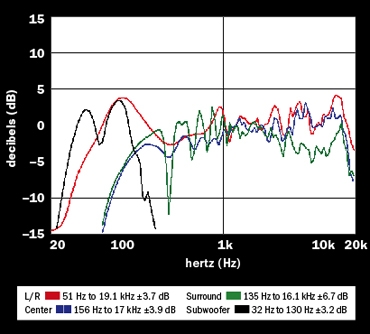Infinity Classia home theater speaker system Page 3

Frequency response (at 2 meters) Front left/right: 51 Hz to 19.1 kHz ±3.7 dB Center: 156 Hz to 17 kHz ±3.9 dB Surround: 135 Hz to 16.1 kHz ±6.7 dB Subwoofer: 32 Hz to 130 Hz ±3.2 dB
Sensitivity (SPL at 1 meter with 2.8 volts of pink-noise input) Front left/right: 91 dB Center: 90 dB Surround: 88 dB
Impedance (minimum/nominal) Front left/right: 4.6/11 ohms Center: 6.0/10 ohms Surround: 3.8/9 ohms
Bass limits (lowest frequency and maximum SPL with limit of 10% distortion at 2 meters in a large room) Front left/right: 62 Hz at 81 dB Center: 100 Hz at 90 dB Surround: 200 Hz at 76 dB Subwoofer: 32 Hz at 104 dB
102 dB average SPL from 32 to 62 Hz 104 dB maximum SPL at 32 Hz Bandwidth uniformity 98%
All of the curves in the frequency-response graph are weighted to reflect how sound arrives at a listener's ears with normal speaker placement. The curve for the left/right front channels reflects response of the C336 with the speaker standing on the floor averaged over a ±30? window, with double weight at 30? (the most typical listening angle). The center-channel curve reflects response of the CC225 averaged over ±45?, with double weight directly on-axis of the primary listener. The surround-channel curve shows the response of the C250ES averaged over ±60?.
Because the C336 is a floorstanding model, measurements were taken with the speaker positioned on a floor. Both the center and surround speakers were measured on a 6-foot stand, which gives anechoic results to approximately 200 Hz. With the exception of the subwoofer, all measurements are taken at a full 2 meters. This arrangement emulates a typical listening distance, allows larger speakers to fully integrate acoustically, and, unlike near-field measurements, fully includes front panel reflections and cabinet diffraction.
The PSW310W Subwoofer bass limits were measured with it set to maximum bandwidth and placed in the optimal corner of a 7,500-cubic-foot room. In a smaller room users can expect 2 to 3 Hz deeper extension and up to 3 dB higher sound-pressure level (SPL).
Tower and center channel speakers
The C336 tower's measurements indicate a wide floor bounce centered at 200 Hz, followed by narrow band irregularities beginning at 800 Hz. The CC225 center channel displays a similar character at higher frequencies, along with a low frequency response that falls quickly below 400 Hz. Overall, the speaker's bass-to-treble balance rises at slightly less than 1 dB per octave. It has reasonably uniform directivity up to ±30º, but severe lobing develops at wider radiating angles. Both speakers' mid/tweeter arrays emitted fairly acute noises when either was given our ramped test signals at frequencies below their specified bass limit. Surround speaker and subwoofer The C250ES surround displays the narrow bandwidth and irregularities typical of bi-directional speakers, along with limited low frequency dynamic capability. (In my opinion all these speakers need sharp high pass filtering at the appropriate Bass Limit frequency.)
When its crossover is bypassed, the PSW310W Subwoofer has response up to 400 Hz, making it useful for pairing with small satellites. The subwoofer has relatively limited dynamic capability and low frequency extension, but its sound pressure abilities are uniformly distributed over its bandwidth. When using the crossover, response extends to 130 Hz (at a marked 150 Hz). However, centering the crossover dial produces a 60-Hz half power point, while moving the control to its minimum setting delivers a 56 Hz crossover point and a -4 dB volume interaction.
- Tom Nousaine
- Log in or register to post comments




















































